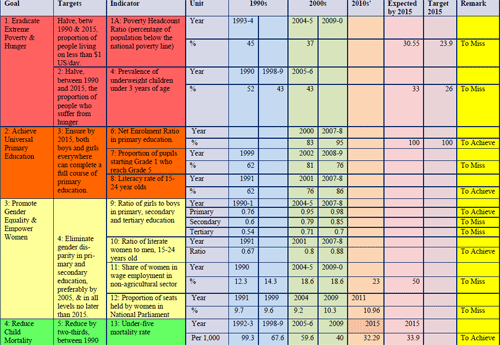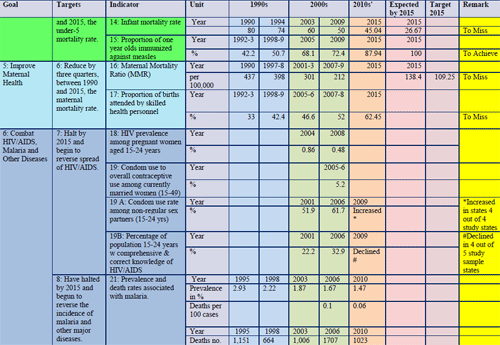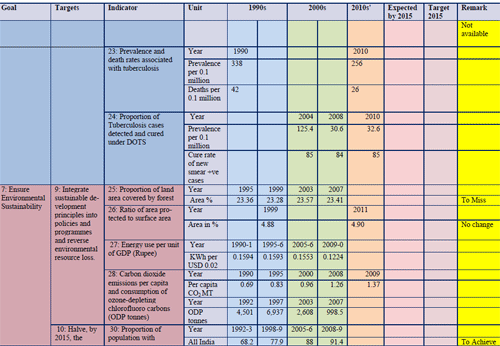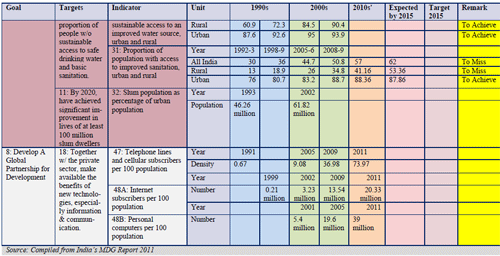Progress towards achieving the Millennium Development Goals 2015
Bhaskara Rao Gorantla, Research Director, National Social Watch, India[1]
Ajay Kumar Ranjan, Research Officer, National Social Watch, India
India’s progress towards achieving the MDGs, as reported in the latest official India MDG Report is summarized at Table 1. As the table shows, India is likely to fall short of a majority of the targets and indicators with respect to Goal 1: poverty and hunger; Goal 3: gender equality; Goal 4: infant mortality, Goal 5: maternal mortality and Goal 7: environmental sustainability, all of which, with the possible exception of environmental sustainability, is appalling. Even the partial successes achieved on targets and indicators with respect to goal 2: education; Goal 6: health, have a few caveats. For example, the school enrollment rates are ahead of the targets, but the dropout rates are also high, making the enrollment rates meaningless. The incidence of HIV/AIDS has come down, but what is alarming is that HIV/AIDS incidence is increasing in states where it was hitherto low. There are also wide variations in the penetration of information and communication devices as agreed under Goal 8: development partnership. And, as the report indicates, the performance of the majority of states on many of the goals and targets is even more appalling. The quality of achievements that have been made is also far from satisfactory.
Issues and challenges
The shortfalls in India’s performance towards achieving these goals can be attributed to three fundamental factors: namely, inadequate funding, inappropriate administration and ignorance of policy and governance issues.
In absolute terms, the government has been mobilizing staggering amounts of resources. For example, the social sector expenditure in the current Five Year Plan, which consists of rural development, elementary education, health and family welfare, women and child development and water and sanitation, has gone up from ₹181.46 billion (USD 3.299 billion) in 1999-2000 to ₹1,788.22 billion (USD 32.513 billion) in 2012-13. However, as a proportion of total expenditure, expenditure for health and family welfare has has fallen, from 9.10% in 2000-01 to 7.01% in 2012-13. During the same period the share going to water and sanitation has declined from 9.80% to 7.73% and the share to social welfare and nutrition has declined from 5.07% to 4.75%. Only the share allocated to education has increased from 10.89% to 14.60%. Even in this area, the goal of spending 6% of GDP on education remained unfulfilled.
The major reason for these shortfalls is that state governments, which are mandated to address social sector needs, are not getting adequate resources and do not have full freedom to mobilize funds from the market and international sources. The central government commands the bulk of the funds and is increasing its allocations towards social sector needs through centrally sponsored schemes (CSSs). But, the cost of administration of these schemes is high and has been increasing steadily over the years, resulting in less funds going to the actually intended purposes. For example, under the Mahatma Gandhi National Rural Employment (MANREGA) scheme, which received ₹1,665.16 billion (USD 30.276 billion) between 2006-07 and 2011-12, only 66% of this amount was spent on actual wage employment and 34% was used for administration and other purposes. Further, there are host of problems with respect to the CSSs, such as leakage, misappropriation of funds, and so on, so that the impact of these schemes is far from satisfactory. India is one of three out of a total of eighty-one study countries which experienced an increase in the hunger index between 2006 and 2011 and is doing worse on health indicators than are less developed countries such as Vietnam and Bangladesh.
The underlying cause of all of these failures is the lack of inclusiveness in the development model. Instead of enabling the people to acquire basic needs such as food, sanitation, water, and health care, the government is promoting ‘non-inclusive growth’ and has sought to provide basic social services through subsidized institutions that all have problems of inefficiency, corruption, and so on. The formal, organized sector, which is the main source of quality employment, employs only 12% to 13% of the country’s workforce. The remaining 87% are relegated to the agriculture and informal sectors with low and uncertain earnings. Though the economy has been growing at phenomenal pace during last decade, employment in the formal sector has declined in absolute numbers from 28.113 million in 1999 to 27.549 in 2008. Further, the quality of employment in this sector has been deteriorating over the last decade.
With the suicide of more than a quarter million farmers in last several years, agriculture has become a crisis for about two-thirds of the population. This crisis has been greatly aggravated by climate change. Although India prepared an ambitious climate change action plan and undertook eight national missions to meet climate change challenges in different sectors, apparently the major focus of these missions is on investment and technologies. More critical issues such as equity, institutional capacity and governance have not received sufficient attention.
Table 1: India’s progress towards achieving the MDGs
 |
 |
 |
 |
The way forward
The “success” that India has achieved through deregulation and other economic reform measures proves that economic liberalization can greatly improve productivity and accelerate economic growth. However, the reform measures have so far been confined to the economic sphere, especially, to the manufacturing and service sectors. The country needs paradigm shifts in agriculture, natural resource management, development planning and governance. Recommendations for bringing about such shifts include:
- Governance: Focus on enabling the people to achieve rights and entitlements on their own rather than making them dependent on the state’s largess. In the short run the direct cash transfer may be the best option instead various subsidies, which have larger administrative costs and lead to various distractions. True decentralization is the best possible method to get genuine peoples’ participation in governance and decision-making. Towards this, the government should implement the reservation of seats for women in the Parliament as well as in state assemblies and councils.
- Economy: Focus on employment oriented products and processes in industrialization and services. Create an enabling environment for entrepreneurship development. Focus on promoting cooperatives instead of only the public-private partnership model.
- Agriculture: Focus on implementing biodiversity cropping patterns in place of the current focus on ‘industrial cultivation.’
Notes:
[1] May be contacted through bhaskara.rao@socialwatchindia.net visit www.socialwatchindia.net
Government of India, Millennium Development Goals: India Country Report 2011 (New Delhi, Central Statistical Office, 2011).
See Planning Commission, Midterm Appraisal of the Eleventh Five Year Plan, New Delhi, 2011. Available at: http://planningcommission.nic.in/plans/mta/11th_mta/chapterwise/Comp_mta11th.pdf. (Accessed on 12 November 2012; and N.C. Saxena, Administrative Reforms for Better Governance (New Delhi: Daanish Books, 2012), p.93.
Government of India Planning Commission, Data for use of Deputy Chairman, New Delhi, 2012, p. 21. Available at: http://planningcommission.nic.in/data/datatable/0904/comp_data0904.pdf. (Accessed on 12 November 2012).
Ministry of Rural Development, “MGNREGA Sameeksha: An Anthology of Research Studies on the Mahatma Gandhi National Rural Employment Guarantee Act, 2005-2006–2012 (New Delhi: Orient BlackSwan, 2012).
S.Mehrotra, A. Gandhi, B. K. Sahoo, and P. Saha, “Creating Employment in the Twelfth Five-Year Plan,” Economic & Political Weekly, Vol. 47, no. 19, 2011.
G. Bhaskara Rao, “Current Climate Variability Adaptation in AP and Available Options,” GEF – FAO – BIRD Strategic Pilot on Adaptation to Climate Change (SPACC) Project, Hyderabad, 2012. Available at: https://docs.google.com/file/d/0B5066u5_umeGYnM5bGd6RHdRZ21PRUVONmJGTEdrZw/edit> (Accessed on 12 November 2012).


